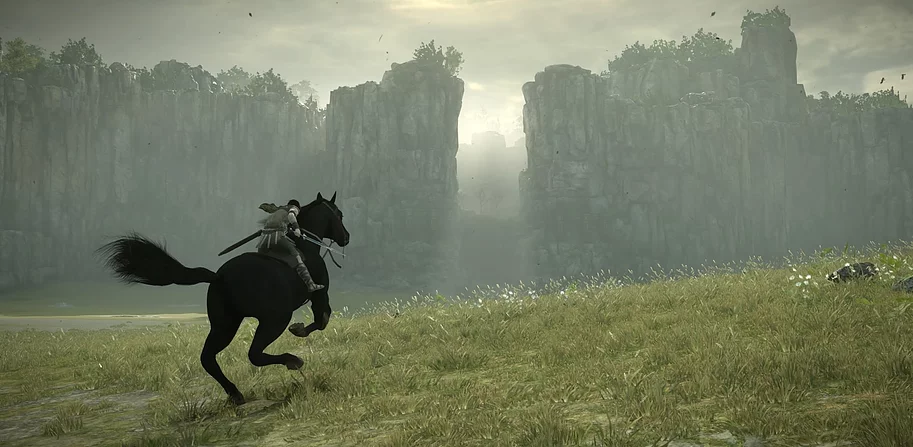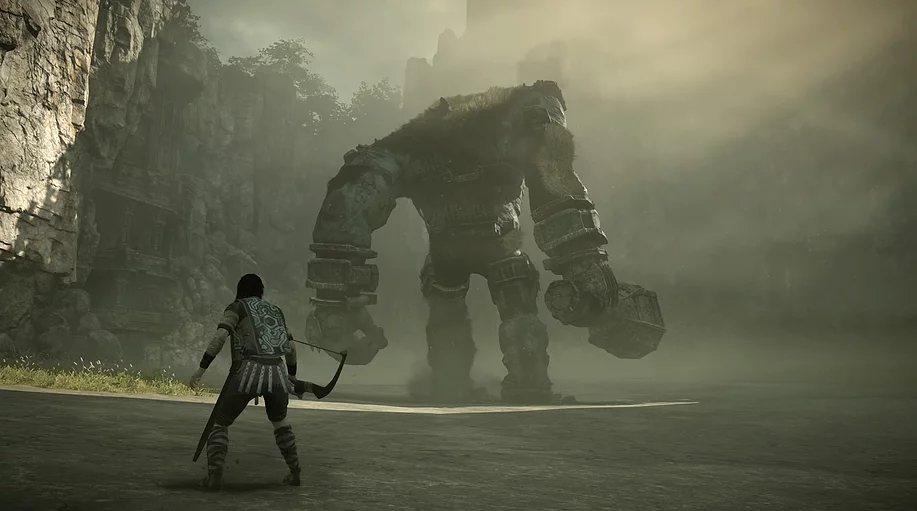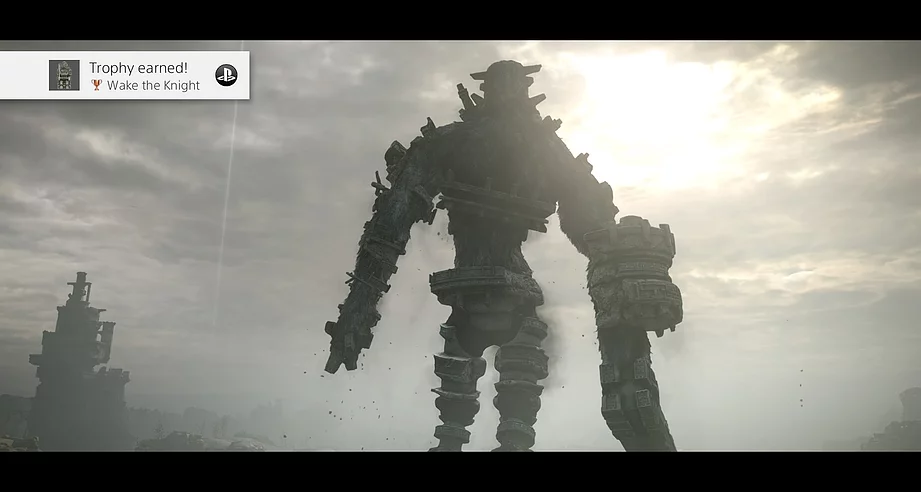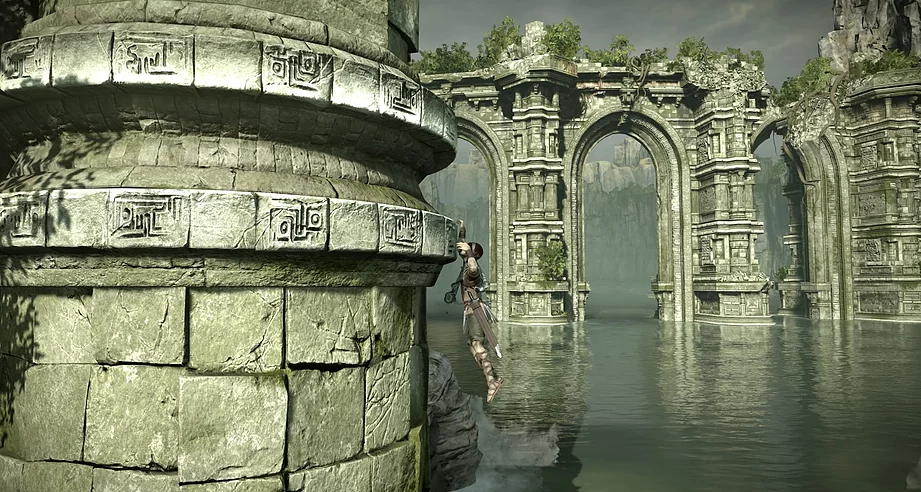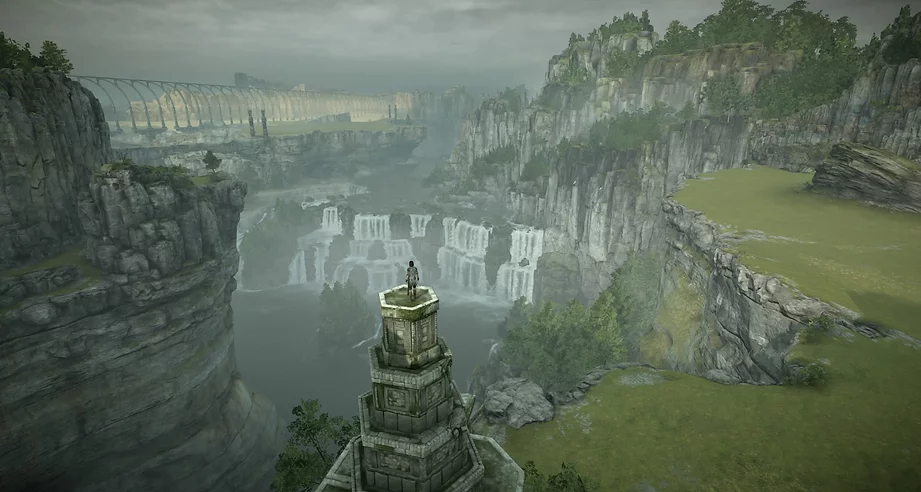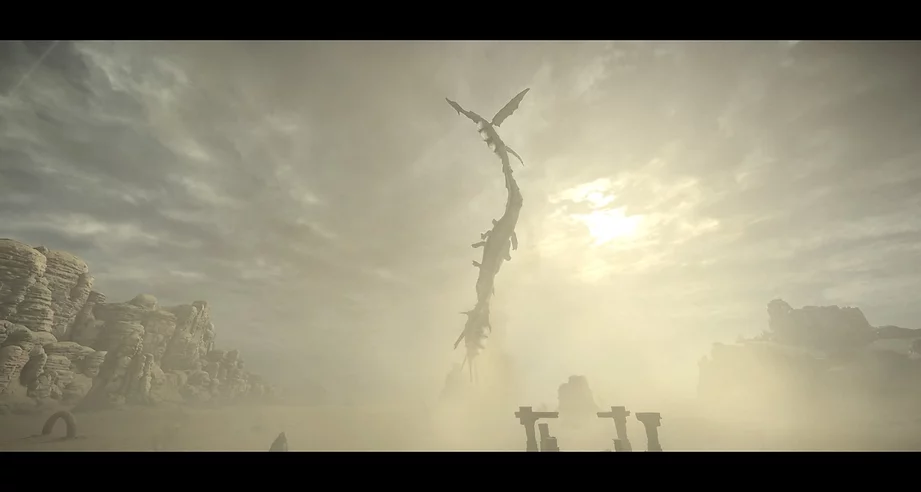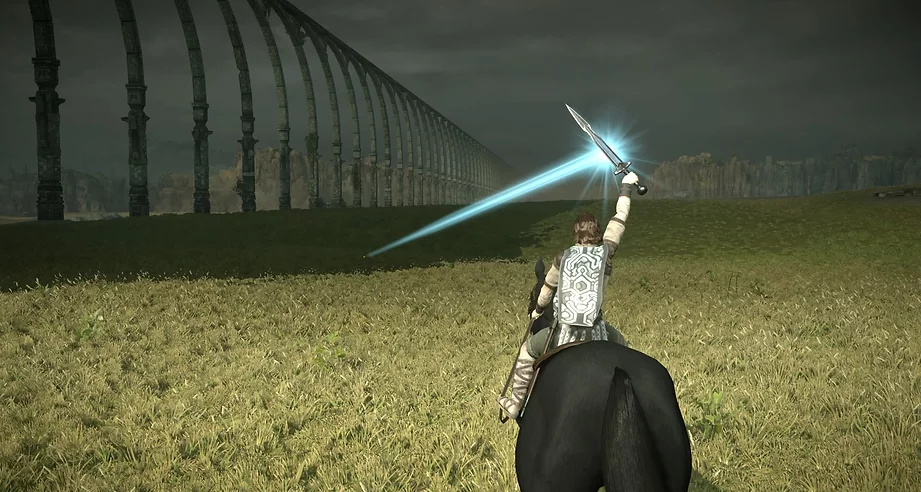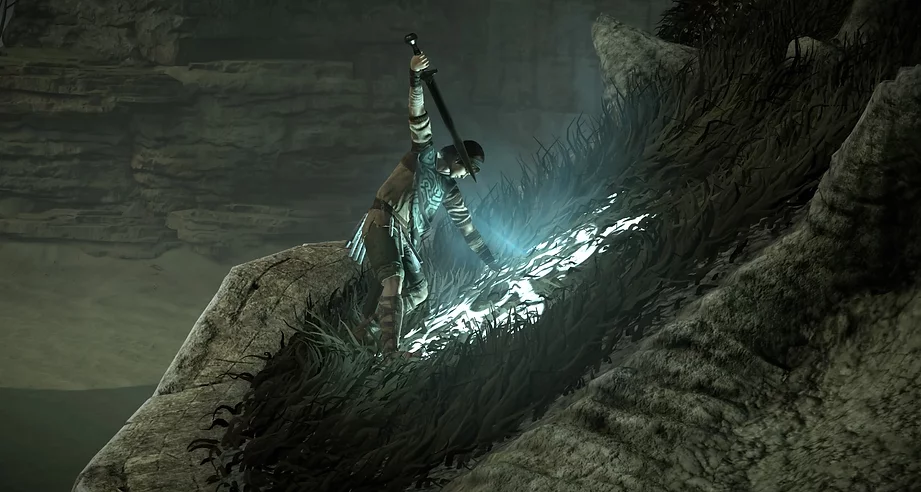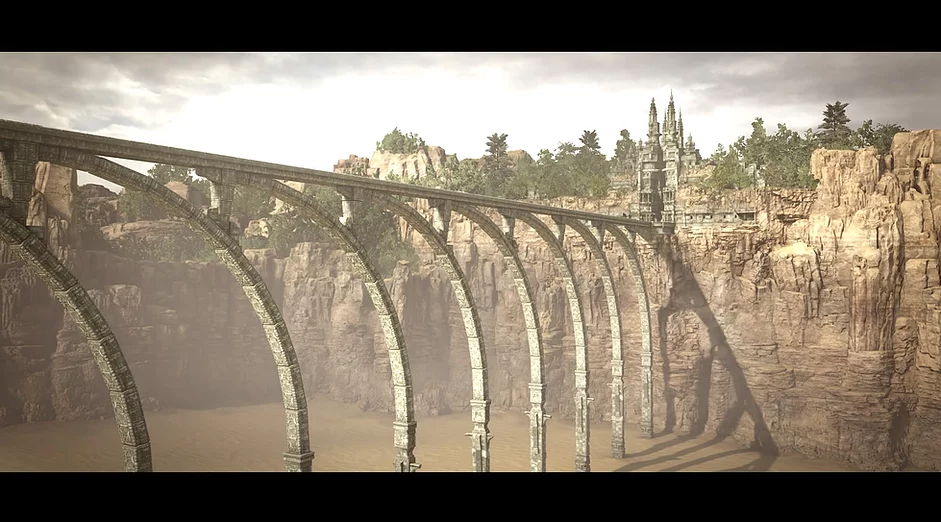
Shadow of the Colossus
Platforms: PlayStation 4 (and 2)
Review date:
Emoji summary: 🙏🏻🐎😬
Review by: GDLP
Spoilers: Whole story
I played Shadow of the Colossus from start to finish in a day. It took me 8 hours and 47 minutes to beat. I would usually play a game in stages and phases of attention but I don’t know, my Saturday was wide open and I thought fuck it, whole game. I pulled the blinds down, got comfy, ordered a Dominos - had the sides for lunch and the pizza for dinner and… I just played. I was like a film critic disappearing into the cinema first thing to watch full length features back to back in time to review; they must come out into a daylight working world that seems suddenly parallel. My outside-world started to reappear when the credits were rolling on the game around 2am and I looked at my phone and all its notifications and felt like I’d skipped a day on this planet. Except, you know how in some stories, characters wake up and think maybe it was all a dream and then they either find something or the audience is shown a token from that other place that proves this really did happen? My fantasy keepsake was that my right index finger was already very, very tired from gripping R2 on the controller and I knew it was going to hurt the next day.
Shadow of the Colossus is cultish, charged. It is the game I am recommended most by our readers and when I speak to people, it seems to have a hold on them for a very long time. I’ve always wondered how and why. The game was developed by SIE Japan Studio and Team Ico, and published by Sony for the PlayStation 2 way back in 2006 before being remastered for the PlayStation 4 in 2018, and that’s the version I went with. I’m in the club now. I’ve played it, loved it, and this game is already haunting me too. I am thinking about it in relation to so many other things, and then when I play those others things I’m thinking back to it, like it is a north star in my head; lodged itself there now, slowly glowing.
The game’s structure is very easy to describe. It starts and ends with cinematics you can kick back and watch, and you do the very narrow gameplay between those bookends. We open with a man on a horse travelling under a dark blue sky through night and through dawn. He crosses a long skeletal bridge that stretches out over sand and leads up to a derelict, ancient temple. It is the only building in sight and it is empty; tall in an unworked landscape of sand, grass, skies, cliffs and some waterfalls way off in the distance. The bridge means the man enters the temple high up, and he follows a spiral path down to the main hall, still on his horse. In there, he looks up through an open dome in the ceiling where he has come to speak to the gods: The Dormin. He has the dead body of a young woman with him that he wants them to revive because he says that, ‘in this place at the ends of the world, there exists a being who can control the souls of the dead.’ The Dormin agree that they can return her soul if he does something for them. They want him to destroy all of the Colossi that live in this land, and explain that the Colossi are incarnations of the idols that line the walls of this temple. If he defeats them, the idols will fall, but he could pay a heavy price if he goes through with this. He brushes that off, determined, and so the gods direct him to raise his sword so that the sunlight can shine off it and reveal the locations of all the Colossi he must face. The scene ends, and that is where the game begins and stays; there are no branching side quests here. Wander must simply head out on his horse Agro, find all 16 of these things, and destroy them to save the woman whose body now lies on the temple’s altar awaiting her resurrection.
Imagine me, optimistic, heading out on my nice horse ready for a fight, turning up to Colossus number one, deeping why they are called Colossi, and thinking ‘oh shit.’ They all differ slightly in their form, size and speed but essentially the 16 Colossi are giant armoured creatures that Wander must scale like a flea. That first one is an ape stories high swinging a hammer but there’s also an elephant knight, a tortoise like a hill that shoots fire from its mouth, and a snake that can dive through the sand like water. The armour on them sometimes looks like an exoskeleton, fully part of their titan body; and when bone covers more of them than any fur, they start to look like possessed rocks moving, swinging and fighting Wander off their arms, legs, wings. Each Colossus is a moving target that you must approach in different ways: they are puzzles to work out that might involve knocking them off balance somehow, trapping them, or just daring them to try and get you so you can get them back. And then to beat them, Wander has to search them for glowing seals that can be pierced with his sword. Once all the seals are broken, the creatures fall to the ground and the whole entity they once were becomes a shadow that disappears with the wind; each end is like the death of a ghost, an exorcism, and the world becomes still again when they leave. So, this is the task. This straightforward game gives you 16 contained objectives in a very concentrated and set order which sounds like an obvious thing to point out here but it’s what I’m left thinking about after playing, because I think it’s part of the reason it really stays with its players - or at least, why it will linger for me.
This game is like the graph on a heart monitor. It is staged in this complete un-worked landscape and palpable emptiness, and then suddenly you are starring in an action movie, and in the next breath you are back to that vast open space, all alone. It swings you between these binaries, like there is no gradation at all, no build-up; it is all highs and lows and so it is pure drama. I’ll describe the graph for you so you can feel it too. We start at the temple and ride out into clear land with the simple mechanic of sword up in the sky as a compass to our fate. Before the next fight begins, there is no significant lead-in like other games might write; no grinding, no characters to psyche you up, give you tips or tell you where to find some specialised weapon for the next Colossus. None of that is necessary. You simply arrive. When Wander walks into the area and the Colossus notices his presence, there are no screaming NPCs fleeing the scene because there’s no one else for miles - it’s just the two of them, hand to hand. This wave from nothing to something big begins to crest and suddenly you are in a difficult near-death experience spurred on by motivating battle music. For the 13th encounter, you face a prehistoric-looking anthropod that is angular, long and flying. It is incredibly fast. While Agro gallops to keep up, you have to shoot arrows up at the sacs along the stomach of the Colossus until it sinks closer to the ground. Then, where the edges of its geometric wings slice into the sand, you have to dive off your horse and onto them. Cling on, grip R2 for dear life, wait until the colossus shoots back up, run onto its body, and then Wander must break the seals on its back all whilst speeding through the air. When it finally falls, there is no celebration after the fact, no congratulations from the game or story, no payout. The wave crashes, the Colossus collapses, and so does Wander. And each time, he regains consciousness back in the temple where he can pick himself up and head out to face another. The drama resets. In this cycle of Wander and player returning again and again to the same place and mood, I found it really grounding. You are brought back to this abandoned land at the end of lands, and all the emptiness fills you again. You feel it as a player because you’ve just completed something hard and now your hands and body can loosen; you can hear it in the soundtrack, and see it before you in pace and symbols; every time you start back at the temple, the woman’s body is surrounded by more doves and they are all grounded too until you walk forward and they fly off in a whirl as you leave.
Those peak moments of action should correlate with some Mission Impossible image of Tom Cruise clinging to the side of a plane but the game sits far, far away from any juiced up Hollywood aesthetic. And I think that’s in the bare face the story comes back to; the palette cleanser it serves between every meal. The screen isn’t busy with menus, maps, details and special effects. The land isn’t littered with monsters to sweep, loot boxes to dig for or villages full of people who just happen to need your help with all these different things. This stuff happens in so many games as normal practice and we accept the deceit of it all because it’s fun busywork, it’s more gameplay, more road. My experience of Shadow of the Colossus is in its difference to these and that plays a big part - I assume it must have done at the time of its release and it might always do for people who play a lot of mainstream games. And this goes a long way in what I think the game achieves: being this stripped down and focused on the one task of killing 16 Colossi should feel repetitive but it just feels determined. The single quest structure without any fuss is more realistic even though none of this is real, but it winds the tension ever tighter until the game’s end. I’ve been thinking a lot about games not in comparison to fine art but to theatre, and in Shadow of the Colossus, it’s like a one-man show where the intermission and the play are taking turns over and over again in this weird but complete ride. It means that so much play is anticipation for when the action will start up again, all the while knowing how quickly it will drain away and how little you will be left with. And it’s not happy, it’s not celebratory. After every Colossus felled, Wander literally collapses and his appearance gradually weakens; it’s like the closer you get to winning, the more it feels like you are about to lose everything. And that it’s - I think that’s the strange romance of this entire thing - and horribly, those feelings are quickly confirmed. Over the final stage of the game, the story digs its nails in bit by bit until it is gripping you like Wander grips onto the limbs of all these giants.
There are a couple of very brief cut scenes that start to show a group are travelling to the temple, and they’re talking vaguely about Wander and you’re not clearly told why. And then as you’re crossing the bridge to the 16th Colossus, the path starts to break apart and Agro, the horse that has carried you this whole way, throws you to safety before falling down off the bridge and into the mist. He’s gone. I honestly yelled. I was not expecting it but it also, painfully, works well in dragging you forward to the finale alone and vulnerable as you should be. With the final Colossus, a beast standing still and breathing heavily, encased in a metal tower stories high, the sky gets dark and it rains for the first time in the whole game. The breakdown is coming.
After you reach the summit of the 16th Colossus and break the seal on its head, you wake up back at the temple as usual - but nothing else is usual about it. Wanders eyes are white, he has small horns, and his skin is grey and marked with these black veins like poison. He’s also not alone. The group that were riding in are there in waiting and they are frantic and horrified at what he’s done. They tell Wander that the gods were only using him, and shoot him down there and then - except there’s nothing mortal left to kill. Wander transforms into a cursed shadow spider that grows out into the towering figure of a devil. And then the Dormin speak their big reveal. They say, ‘Thou severed our body into sixteen fragments for an eternity in order to seal away our power. We, Dormin, have arisen anew… We have borrowed the body of this warrior.’ The Dormin are the real threat and the Colossus were only guarding the locked up pieces of their body, separated and held in each of them like Pandora’s box(es). Wander’s quest to revive the woman he brought here was at the cost of not only his own life but everybody’s safety; and I had this awkward moment as the player where I realised I’d been rooting for the antihero, and I agreed now with the group who’d come to stop him much too late.
The leader of the group, who wears a mask like an owl, manages to seal the shrine back up by returning to the top of the temple and dropping Wander’s sword into the pool at its bottom, and they run off on their horses along the skeletal bridge from the beginning of the game. This last half hour is a mostly unplayable scene and I was sat there in the middle of the night gripped watching it all take place; there is this moment before the seal is finished where a shadow body is climbing and trying to walk forward to the altar while he is blown back into the abyss and it is the last essence of Wander - trying to get back to the girl. It’s pretty sad. So then the dust settles, the woman wakes up, and I felt myself breathe out. I then fully started to tear up because after she climbs off the plinth, having missed the whole saga, curse and deal that took place so that she might be revived, AGRO WALKS IN. Agro, the horse, walks in limping with his head bowed, so slow. My eyes were blurry because I didn’t think he could ever survive the fall, but also because he managed to push his way here through the pain, and he was returning not to his owner but to the woman they saved together just as she woke up. Ah, my heart. The two of them walk forward through the temple and they find a baby at the bottom of the pool where the Dormin and the lost shadow Wander have been sealed. The baby has horns like Wander had started to grow before he died, and she takes him to a garden on the roof of the temple and just as the game is ending I realised the buttons I pressed made the baby move slightly implying that this kid is Wander reborn. And it ends.
I wouldn’t usually write out a frame for frame ending but I’m learning how many of the people who read these game reviews don’t have consoles themselves and read for other reasons completely. I like that, and just to say that you can watch both the beginning and ends scenes on YouTube if you want to see what happens in person. But I also wanted to write about the ending because I don’t know if I loved that part of Shadow of the Colossus as much as I did the rest of it, because how do we go from ‘oh god, the Dormin have been playing Wander this whole time and now they are released upon the world, oh god’ to ‘these strange men have put them back in a box already, never mind’? After you’ve climbed the mountain of this whole game, it feels weirdly patronising for strangers to pop in, save the day and ride off in a matter of minutes. It collapses the drama that was built up over the 16 battles; but then so does Wander’s survival. It’s a bit generous that he gets another shot at life when he was selfish and he knew what he was gambling when he set out to kill the Colossi. This story is completely resolved but it’s hasty, and what I think it should have come down to is that reset again, that emptiness: the woman alone with the horse like Wander had been before them, with all the potential for what might come next. Ultimately, I think the ending we get is too happy for the tragedy this story seemed to be telling. They should have gone all in. But I’m glad I played it. It was so much better than The Last Guardian! And I feel like I am becoming this Well-Played Gamer because I can see the influence Shadow of the Colossus has had on stories and designs ever since (thinking of Breath of the Wild in particular; the Divine Beasts are Colossi, the Molduga diving in and out of the sand are like Phalanx and the snake Colossus - but that’s another text). This is a classic and it will stay with me, like it has stayed with you all, for a very long time.
If you’re here at the end of the text, please comment a 🙏🏻 emoji on our Instagram or share the text with a 🙏🏻 emoji on Twitter
